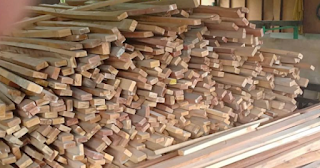Understanding good lumber in the Philippines, and a wood priced P750k per kilo
Wood holds a lasting appeal for Filipinos, deeply ingrained in our culture and history. Over time, wood has been used for various needs, like fuel, construction, and furniture. Despite its importance, we often overlook wood's value even as its demand and conflicts over resources persist.
De Guzman, et al. (2009) defines “good lumber” as a commercially available wood that is used as structural parts in the Philippines. This mainly includes imported wood and less-known local types. A survey in Metro Manila found that 56% of lumberyards sell locally sourced good lumber, while 44% import it. However, often the specific wood type and properties are not clearly stated.
What is the best wood material in Philippines?
Wood is a fundamental material in furniture crafting, serving as the essential building block. Its versatility allows for crafting furniture from various wood types. Unique traits characterize common wood varieties, offering distinctive warmth, accent, and beauty to homes. With its timeless allure, natural aesthetics, and durability, wood furniture seamlessly complements diverse home designs.
Choosing the right wood furniture entails understanding the properties of different wood types. Here are some frequently used wood options in the Philippines:
Ash Wood:
Known for its strength and bending capabilities, ash wood is favored for furniture with curved elements. Its light brown hue, straight grain, and robustness make it versatile and long-lasting.
Beech Wood:
Renowned for its sturdiness and resilience, beech wood boasts a pale color with a tight grain. Its shock-resistant nature and ease of workability make it a favorite among craftsmen.
Kamagong Wood:
Indigenous to the Philippines, kamagong wood is characterized by its black heartwood and gray sapwood. It's highly sought after for crafting vintage furniture pieces.
Mahogany Wood:
Mahogany, a prized timber, ranges in color from deep brown to crimson. Its versatility and resistance to damage make it a historic and elegant addition to any property.
Maple Wood:
This enduring wood is moisture-resistant and sturdy, with a visually appealing grain pattern. It's suitable for creating durable, sustainable furniture.
Molave Wood:
for its strength and smooth texture, molave wood is used in furniture, carpentry, and construction due to its durability.
Narra Wood:
A national symbol of resilience, narra wood is indigenous to the Philippines. Its exceptional quality and resistance to pests make it an enduring choice for furniture.
Tanguile Wood:
Often referred to as Philippine Mahogany, tanguile wood's durability and versatility make it ideal for furniture, stair treads, and door frames.
Yakal Wood:
Yakal is lauded for its strength and resilience, suitable for sturdy installations like bridges and furniture.
Walnut Wood:
With a spectrum of shades, walnut wood offers both durability and aesthetic appeal, adding uniqueness to home decor.
What is the most expensive wood in the Philippines?
In an article published by Esquire Philippines, "lapnisan" is described as a rare and valuable agarwood. This resin-rich wood is highly sought after for its aromatic properties and use in luxury perfumes and traditional medicines. A kilo of Agarwood is said to cost Php750,000.
Agarwood is formed when certain trees are infected by a specific mold, causing the wood to develop a distinctive fragrance. The scarcity and labor-intensive process of harvesting agarwood contribute to its high market value. However, illegal logging and overharvesting pose serious threats to the agarwood industry, prompting conservation efforts to protect this precious resource.
The diverse range of wood furniture options in the Philippines requires a comprehensive understanding of their features, styles, and preferences. While imported wood may seem superior, locally-sourced options are equally high-quality. Prioritizing needs and preferences is essential when choosing wood furniture, ensuring that longevity, aesthetics, and functionality align with your vision for your home.




Comments
Post a Comment